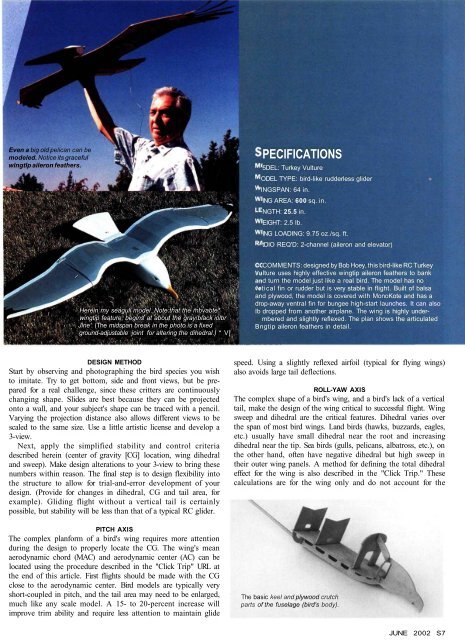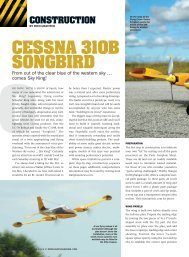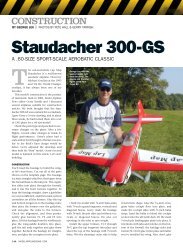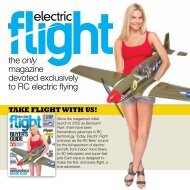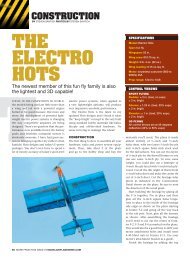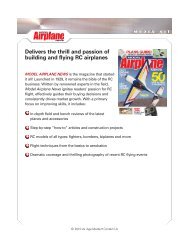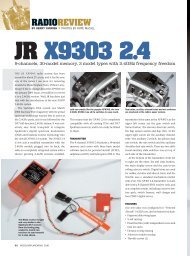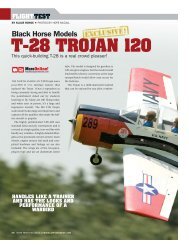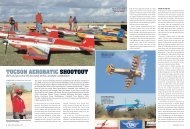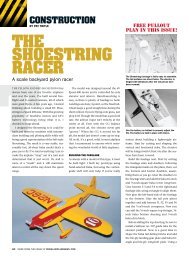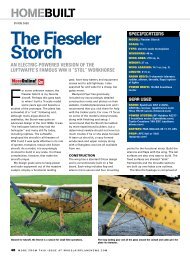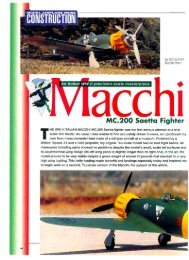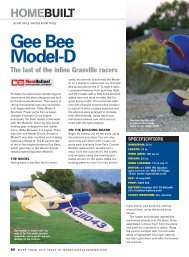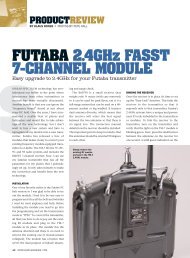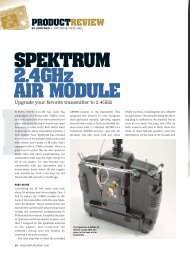Create successful ePaper yourself
Turn your PDF publications into a flip-book with our unique Google optimized e-Paper software.
Even a big old pelican can be<br />
modeled. Notice its graceful<br />
wlngtlp aileron feathers.<br />
Herein my seagull model.,Note:that the mbvabte*<br />
wingtip feature, begins at about the gray/black iolbr<br />
Jlne'. (The midspan break in the photo is a fixed<br />
ground-adjustable joint for altering the dihedral.) * V|<br />
DESIGN METHOD<br />
Start by observing and photographing the bird species you wish<br />
to imitate. Try to get bottom, side and front views, but be prepared<br />
for a real challenge, since these critters are continuously<br />
changing shape. Slides are best because they can be projected<br />
onto a wall, and your subject's shape can be traced with a pencil.<br />
Varying the projection distance also allows different views to be<br />
scaled to the same size. Use a little artistic license and develop a<br />
3-view.<br />
Next, apply the simplified stability and control criteria<br />
described herein (center of gravity [CG] location, wing dihedral<br />
and sweep). Make design alterations to your 3-view to bring these<br />
numbers within reason. The final step is to design flexibility into<br />
the structure to allow for trial-and-error development of your<br />
design. (Provide for changes in dihedral, CG and tail area, for<br />
example). Gliding flight without a vertical tail is certainly<br />
possible, but stability will be less than that of a typical RC glider.<br />
PITCH AXIS<br />
The complex planform of a bird's wing requires more attention<br />
during the design to properly locate the CG. The wing's mean<br />
aerodynamic chord (MAC) and aerodynamic center (AC) can be<br />
located using the procedure described in the "Click Trip" URL at<br />
the end of this article. First flights should be made with the CG<br />
close to the aerodynamic center. Bird models are typically very<br />
short-coupled in pitch, and the tail area may need to be enlarged,<br />
much like any scale model. A 15- to 20-percent increase will<br />
improve trim ability and require less attention to maintain glide<br />
PECIFICATIONS<br />
5DEL: Turkey Vulture<br />
ODEL TYPE: bird-like rudderless glider<br />
'INGSPAN: 64 in.<br />
ING AREA: 600 sq. in.<br />
NGTH: 25.5 in.<br />
EIGHT: 2.5 Ib.<br />
ING LOADING: 9.75 oz./sq. ft.<br />
tDIO REQ'D: 2-channel (aileron and elevator)<br />
COMMENTS: designed by Bob Hoey, this bird-like RC Turkey<br />
Iture uses highly effective wingtip aileron feathers to bank<br />
d turn the model just like a real bird. The model has no<br />
^rtical fin or rudder but is very stable in flight. Built of balsa<br />
and plywood, the model is covered with MonoKote and has a<br />
drop-away ventral fin for bungee high-start launches. It can also<br />
Ib dropped from another airplane. The wing is highly undermbered<br />
and slightly reflexed. The plan shows the articulated<br />
Bngtip aileron feathers in detail.<br />
speed. Using a slightly reflexed airfoil (typical for flying wings)<br />
also avoids large tail deflections.<br />
ROLL-YAW AXIS<br />
The complex shape of a bird's wing, and a bird's lack of a vertical<br />
tail, make the design of the wing critical to successful flight. Wing<br />
sweep and dihedral are the critical features. Dihedral varies over<br />
the span of most bird wings. Land birds (hawks, buzzards, eagles,<br />
etc.) usually have small dihedral near the root and increasing<br />
dihedral near the tip. Sea birds (gulls, pelicans, albatross, etc.), on<br />
the other hand, often have negative dihedral but high sweep in<br />
their outer wing panels. A method for defining the total dihedral<br />
effect for the wing is also described in the "Click Trip." These<br />
calculations are for the wing only and do not account for the<br />
The basic keel and plywood crutch<br />
parts of the fuselage (bird's body).<br />
JUNE 2002 S7


